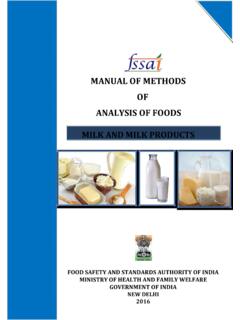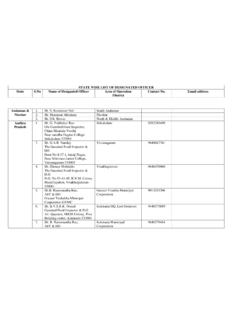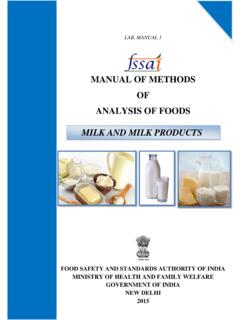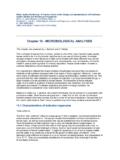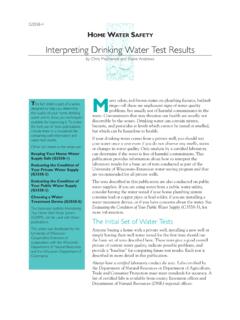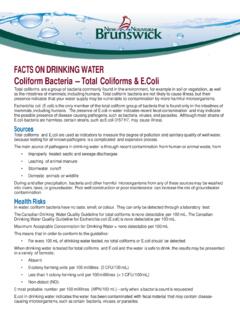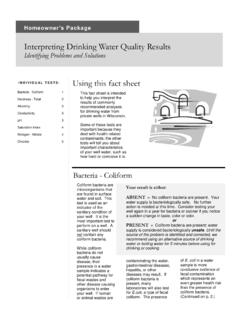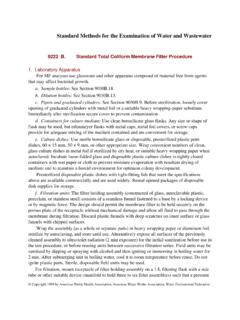Transcription of MANUAL OF METHODS OF ANALYSIS OF FOODS - FSSAI
1 LAB. MANUAL 4 MANUAL OF METHODS OF ANALYSIS OF FOODS food SAFETY AND STANDARDS AUTHORITY OF INDIA MINISTRY OF HEALTH AND FAMILY WELFARE GOVERNMENT OF INDIA NEW DELHI 2015 BEVERAGES (COFFEE, TEA, COCOA, CHICORY) SUGAR AND SUGAR PRODUCTS & CONFECTIONERY PRODUCTS ACKNOWLEDGEMENT Deepest Sense of Gratitude and Indebtedness to all the Members of the Panel Method of Sampling and ANALYSIS and Experts, who have helped, supported knowledge and insight, have led the successful completion of Revision of manuals. Sincere Thanks to the Panel, Chairman for his valuable guidance, and encouragement and the Secretariat of this panel who have worked hard throughout the tenure of revision work.
2 Deepest Appreciation to the Chairperson, FSSAI and CEO, FSSAI for the cooperation, support and constant encouragement, without which the work would not have seen the light of day. ** Beverages, Sugar and Confectionery Product 2015 1 MANUAL FOR ANALYSIS OF BEVERAGES (COFFEE, TEA, COCOA, CHICORY), SUGAR AND SUGAR PRODUCTS AND CONFECTIONERY PRODUCTS TABLE OF CONTENTS TITLE PAGE NO. PART A- BEVERAGES AND SUGAR AND SUGAR PRODUCTS Roasted Coffee 4 Chicory and Coffee Chicory Mixture 20 Soluble (Instant) Coffee Powder 21 Cocoa 22 Tea 24 Honey 29 Cane Sugar and Refined Sugar 40 Bura 52 Gur or Jaggery 53 Sulphated ash in Dextrose 53 Starch in Icing Sugar 54 total Solids in Liquid Glucose 54 PART B - CONFECTIONERY PRODUCTS A.
3 SUGAR BOILED CONFECTIONERY AND LOZENGES A1 Preparation of Sample 57 A2 Determination of Moisture 57 A3 Determination of Sulphated Ash 59 A4 Determination of Sulphated Ash on salt free basis 60 A5 Determination of Ash in dil HCl 61 A6 Test for presence of added synthetic colour 63 A7 Determination of total Protein 68 A8 Determination of Fat 71 A9 Determination of Reducing Sugar 75 A10 Determination of Sucrose 76 A11 Determination of Sulphur dioxide 77 A12 Determination of Lead, Copper and Zinc 80 A13 Determination of Filth in Candy 83 Beverages, Sugar and Confectionery Product 2015 2 TITLE PAGE NO. A14 Determination of Starch 86 A15 Determination of Paraffin 88 A16 Determination of Shellac 89 A17 Determination of Alcohol in Syrups 90 A18 Determination of total Plate Count 91 A19 Determination of coliform 94 A20 Determination of Yeast and Mould Count 97 A21 Determination of 102 A22 Determination of Staphylococcus aureus 104 B.
4 CHEWING GUM AND BUBBLE GUM B1 Preparation of Sample 106 B2 Determination of Moisture 107 B3 Determination of Ash in dil HCl 108 B4 Determination of Sulphated Ash 109 B5 Test for presence of added synthetic colour 110 B6 Determination of Titanium dioxide 112 B7 Determination of Gum- Base Content 113 B8 Determination of Reducing Sugar 115 B9 Determination of Sucrose 116 B10 Determination of total Protein 116 B11 Determination of Fat 116 B12 Determination of Lead, Copper and Zinc 116 B13 Determination of Filth 116 B14 Determination of total Plate Count 116 B15 Determination of coliform 116 B16 Determination of Yeast and Mould Count 116 B17 Determination of 116 B18 Determination of Staphylococcus aureus 116 C.
5 CHOCOLATE C1 Preparation of Sample 118 C2 Determination of Moisture 118 C3 Determination of Fat 120 C4 Determination of Non Fat Milk Solids 122 C5 Test for Rancidity 125 C6 Determination of Ash in dil HCl 125 C7 Determination of Milk Fat 126 C8 Determination of Cocoa Solids 130 Beverages, Sugar and Confectionery Product 2015 3 TITLE PAGE NO. C9 Determination of Reducing Sugar 131 C10 Determination of Sucrose 132 C11 Determination of Chocolate Component of Filled Chocolate 132 C12 Determination of Edible Wholesome Substances 132 C13 Determination of total Protein 133 C14 Determination of Lead, Copper and Zinc 133 C15 Determination of Filth 133 C16 Determination of total Plate Count 134 C17 Determination of coliform 134 C18 Determination of Yeast and Mould Count 134 C19 Determination of 134 C20 Determination of Staphylococcus aureus 134 D.
6 ICE LOLLIES OR EDIBLE ICES D1 Determination of Reducing Sugar 134 D2 Determination of Sucrose 134 D3 Determination of Lead, Copper and Zinc 134 D4 Determination of total Plate Count 135 D5 Determination of coliform Count 135 D6 Determination of Yeast and Mould Count 135 D7 Determination of 135 D8 Determination of Staphylococcus aureus 135 D9 Determination of Salmonella 135 D10 Determination of Listeria monocytogenes 140 Beverages, Sugar and Confectionery Product 2015 4 MANUAL FOR ANALYSIS OF BEVERAGES (COFFEE, TEA, COCOA, CHICORY), SUGAR AND SUGAR PRODUCTS AND CONFECTIONERY PRODUCTS PART A BEVERAGES AND SUGAR AND SUGAR PRODUCTS COFFEE - Definitions of different types of Coffee are given under section of food Safety and Standards ( food Product Standards and food Additives) Regulations, 2011.
7 Roasted Coffee Preparation of sample: Grind the sample in a grinder to pass through No. 30 mesh sieve. Mix well to get a homogenous sample. Store sample in a tightly stoppered bottle, Withdraw portions for analytical determinations. (Ref: - 17th edn, 2000 Official Method Roasted Coffee Preparation of sample) 1. 2 Determination of moisture: (Routine method) Weigh accurately about 5 gms of sample in a tared aluminium dish. (About cm in dia and cm deep). Dry in an air oven at 100 20 C for 5 to 6 hours. Cool in a desiccator and weigh. Dry again for 30 minutes, cool in a dessicator and weigh. Repeat the process of heating and cooling in a dessicator until the difference in two successive weighings is less than 1 mg.
8 Record the lowest weight. Carry out the determination in duplicate. Beverages, Sugar and Confectionery Product 2015 5 Calculation W1 W2 Moisture (%) = x 100 (by weight) W1 W Where, W = Weight in gms, of Aluminium dish. W1 = Weight in gms, of Aluminium dish + sample before drying. W2 = Weight in gms, of Aluminium dish + dried sample. (Ref: - Handbook of food ANALYSIS (Part IX) 1984 page 51 / 3077: 1972 Specification for roasted and ground Coffee) A Determination of Moisture - Vaccum Oven method (Reference method) Apparatus 1. Aluminium dish 7 cm diameter and about 3 cm height with close fitting cover.
9 2. Dessicator 3. Vaccum oven connect with pump capable of maintaining partial vaccum in oven A with pressure equivalent to 25 mm Hg and provided with thermometer passing into the oven in such a way that the bulb is near the test sample. Connect H2 SO4 gas drying bottle with oven to admit dry air when releasing vaccum Procedure Accurately weigh about 5 gm of sample in a dish previously dried at Beverages, Sugar and Confectionery Product 2015 6 98 1000 C, cooled in dessicator and weighted with cover soon after attaning room temperature. Place in oven, lean cover against dish and heat to constant weight (about 5 1/2 hrs) at 98 1000 C at pressure equal to 25 mm Hg.
10 During heating admit slow current of air (about 2 bubbles / second) through H2SO4 into oven. Carefully admit dry air into oven to bring to atmospheric pressure. Cover dish, transfer to dessicator and weigh soon after room temperature is attained. Report percent loss in weight as moisture. (Ref: - 17th edn, 2000 Official Method Moisture (Loss on Drying in Roasted Coffee, Vacuum Oven method 1) Determination of total ash: Weigh accurately about 5 gms of sample in a tared silica / platinum dish Char the material carefully on a burner and transfer the dish to a muffle furnace and ash at a temperature of 550 10 0 C until the ash is free of Carbon.)
